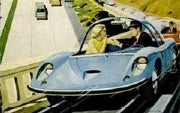Google's Self-Driving Cars and Previous Attempts
 Less than two weeks ago, I attended a talk by Google CEO Eric Schmidt at the TechCrunch Disrupt conference. Schmidt spoke about a profoundly computer-augmented future, and said that there was no reason why super-safe self-driving cars couldn't be built-in fact, he said he couldn't understand why humans were allowed to drive automobiles at all. (As is fairly common with Schmidt comments, it wasn't entirely clear where that comment sat on the continuum from utter frivolity to deadly seriousness).
Less than two weeks ago, I attended a talk by Google CEO Eric Schmidt at the TechCrunch Disrupt conference. Schmidt spoke about a profoundly computer-augmented future, and said that there was no reason why super-safe self-driving cars couldn't be built-in fact, he said he couldn't understand why humans were allowed to drive automobiles at all. (As is fairly common with Schmidt comments, it wasn't entirely clear where that comment sat on the continuum from utter frivolity to deadly seriousness).
At the time, I wondered whether Google wanted to control the computers that controlled the world's cars. Now we know the answer: It does, or at least it wants to play an active role in inventing the technology.As the New York Times' John Markoff reports and a Google blog post discloses, Google has been working on developing cars that can drive themselves. One such vehicle, a modified Prius, motored its way down the coast from San Francisco to Santa Monica. (Its route apparently came within a couple of miles of my house-maybe I shared the road with it.) The idea may stretch the definition of Google's mission-"to organize the world's information and make it universally accessible and useful"-but the noble goals include saving lives, reducing pollution, and generally making travel more efficient.
The Google blog post says that its autopilot vehicles have logged more than 140,000 miles to date, which presumably means the project has been going on for quite a while. It sounds cool, but I'm unclear why it's apparently been secret until now, or why Schmidt spoke so cryptically and so recently of laws restricting the roads to self-driving cars without mentioning that Google was building them.
Google isn't the only outfit working on this idea-a few months ago, I went for a very brief ride in a self-driving, self-parking Volkswagen developed at Stanford University. And the basic idea has been fodder for magazines such as Popular Mechanics and Popular Sciencefor decades. Herewith, a few examples from the past seventy-seven years ago-none of which seem to have gotten as far as Google's experiments.

They've Gone Automatic
Popular Mechanics, August 1933, "They've Gone Automatic!"
In 1933, recent breakthroughs such as automatic garage door openers and power steering felt like the first steps towards fully automated cars. An uncredited Popular Mechanics author argued-not very convincingly-that it would be a straightforward home project to modify a roadster to start itself at an appointed time in the morning, open the garage door, and back itself out into the driveway. The writer also seemed to think that the invention of automatic transmissions provided most of the technology needed for self-driving cars to take to the streets.
 No Hands
No HandsPopular Science, May 1958, "The Car That Drives Itself"
A report on car-automation experiments by GM, Ford, and Chrysler. GM's, which involved embedding cable in highways and planting radio-control boxes by the side of the road, sound the most ambitious and least practical. A Ford engineer sniffs that GM's idea would take a century to implement-which means that even in 2010, it isn't yet hopelessly behind schedule.
 Dream Car Popular Mechanics, August 1958, "This Car Has Electric Brains"
Dream Car Popular Mechanics, August 1958, "This Car Has Electric Brains"A Los Angeles college instructor has spent $12,000 designing a car that uses sound beams, gyroscopes, and other technologies to drive, steer, and brake itself. It also has electric doors and a record player. According to the story, he likes to lounge in the back seat when he takes his invention out on the road.
 helmets
helmetsPopular Science, April 1967, "Automatic Car has Single Control"
Ohio State University researches have built a car that's drivable with a single T-control, with the goal of eventually designing an entirely automated vehicle. The drivers in the photo above are sensibly wearing helmets; if I ever buy a self-driving Googlemobile, I might don one myself.
 Urbmobile
UrbmobilePopular Science, October 1967, "How You'll ‘Drive' the Amazing Urbmobile"
The Cornell Aeronautical Laboratory's "Urbmobile" is a dual-mode electric car that can be driven traditionally on roads or glide at 60mph in automated mode along a subway-style track. It was funded by a $100,000 federal government grant, and the idea was to make it a reality by 1985 at the latest. Very Tomorrowland-esque.
 Automated highway
Automated highwayPopular Science, May 2000, "Your Robot Chauffeur"
A stretch of San Diego highway paved with magnetic "nails" allows prototype cars from Honda and Buck to drive themselves; Nissan and Mercedes are experimenting with machine-vision systems which would let cars see the road in front of them.
Unlike some past automatic-car researchers, Google is being careful about managing people's expectations. (blog post: "...this project is very much in the experimental stage"). Any guesses about whether the company's investments are likely to lead to anything that'll change the world any time soon?
No comments:
Post a Comment